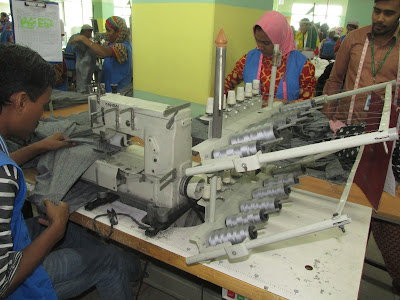Qualified
Worker: is a person who has the
necessary physical and mental attributes, and at the same time has the
appropriate skills and tools to perform the job.
One
who has acquired the skill, knowledge and other attributes to carry out the
work by meeting the standards of quantity, quality, & safety.
 |
| A Multi needle Kansai Machine |
Time:
The length of time taken to complete the job,
usually expressed as labor standard or standard time.
Normal
Working Condition: The acceptable
working environment in terms of temperature, humidity, lighting, noise, etc.
needed to perform the job.
Time
Study: Time Study is a
process for measuring the required time for performing a given task by a given
method by a trained worker working in a normal pace.
It
is a procedure to determine a certain amount of time required to perform a task
involving either human or machine under certain standard conditions of
measurement which consider
1.
Specified Work.
2.
Well Trained Worker.
3.
Normal Pace.
4.
Allowance.
Time Study is the development
of a standard time by observing a task an analyzing it with the use of a
stopwatch.
SMV: SMV means Standard Minute Value.
Standard Minute Value is a numerical
value which is represented the standard time of a process or operation in a
standard environment for standard worker.
Standard
Time is a total time in which a job should be completed of a standard performance.
SMV=
It should be expressed always in minutes.
= Time taken from a standard operator to complete any given
operation with pre-define condition.
The amount of time a qualified worker should spend to
complete a specified task, working at sustainable rate, using given methods,
and equipment, raw materials and workplace.
Standard
Time = (Average Observe Time × Rating) + Allowance.
Allowance: Different types of
allowance are allowed in apparel production floor, such as personal time
allowance, delay allowances, fatigue allowances, etc.
Cycle
Time: Total time taken to do all works to complete one
operation i. e; time from pick up part of first piece to next pick up of the
next piece.
Md. Farid Ahmed
IE Officer
Fakir Apparels Ltd.
BSCIC Industrial Area, Enayet Nagar,
Fatulla, Narayangonj, Bangladesh.
Contact : +8801814220987
Email: farid.ieconcern@gmail.com
IE Officer
Fakir Apparels Ltd.
BSCIC Industrial Area, Enayet Nagar,
Fatulla, Narayangonj, Bangladesh.
Contact : +8801814220987
Email: farid.ieconcern@gmail.com

No comments:
Post a Comment